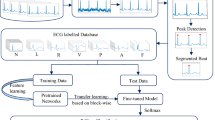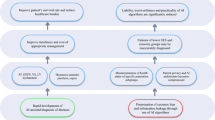Abstract
Cardiac arrhythmia has now become a common condition that affects millions of people worldwide. Arrhythmia can be detected and anticipated early, allowing for more effective treatment and better comprehension of the results. The various machine learning–based methods for detecting various cardiac arrhythmias are reviewed in this investigation. An enormous assortment of electrocardiogram (ECG) information from people with different arrhythmias was utilized to prepare the models broke down in this review. The studies employ various machine learning and deep learning methods to accurately diagnose arrhythmia and comprehend intricate patterns in electrocardiogram (ECG) data. In addition, we investigate how various electrocardiogram (ECG) signal qualities affect the performance of various models. This research takes the employed studies into consideration and compare their results.
Access this chapter
Tax calculation will be finalised at checkout
Purchases are for personal use only
Similar content being viewed by others
References
Fenton, F. H., Cherry, E. M., & Glass, L. (2008). Cardiac arrhythmia. Scholarpedia, 3(7), 1665. https://doi.org/10.4249/scholarpedia.1665
Abdelfattah, O., Martinez, M., Sayed, A., et al. (2022). Temporal and global trends of the incidence of sudden cardiac death in hypertrophic cardiomyopathy. Journal of the American College of Cardiology: Clinical Electrophysiology, 8(11), 1417–1427. https://doi.org/10.1016/j.jacep.2022.07.012
Sahoo, S., et al. (2022). Deep learning-based system to predict cardiac arrhythmia using hybrid features of transform techniques. Intelligent Systems with Applications, 16, 200127. https://doi.org/10.1016/j.iswa.2022.200127
Sai, Y. P., & Kumari, L. V. R. (2022). Cognitive assistant DeepNet model for detection of cardiac arrhythmia. Biomedical Signal Processing and Control, 71, 103221. https://doi.org/10.1016/j.bspc.2021.103221
Prabhakaran, D., Jeemon, P., & Roy, A. (2016). Cardiovascular diseases in India: Current epidemiology and future directions. Circulation, 133(16), 1605–1620. https://doi.org/10.1161/CIRCULATIONAHA.114.008729
Apandi, Z. F. M., Ikeura, R., & Hayakawa, S. (2018). Arrhythmia detection using MIT-BIH dataset: A review. In 2018 International Conference on Computational Approach in Smart Systems Design and Applications (ICASSDA). IEEE. https://doi.org/10.1109/ICASSDA.2018.8477620
Van Mieghem, C., Sabbe, M., & Knockaert, D. (2004). The clinical value of the ECG in noncardiac conditions. Chest, 125(4), 1561–1576. https://doi.org/10.1378/chest.125.4.1561
Jaeger, F. J. (2010). Cardiac arrhythmias. Cleveland Clinic. Retrieved 2010.
Sai, Y. P. (2020). A review on arrhythmia classification using ECG signals. In 2020 IEEE International Students’ Conference on Electrical, Electronics and Computer Science (SCEECS). IEEE. https://doi.org/10.1109/SCEECS48394.2020.9
Moody, G. B., & Mark, R. G. (2001). The impact of the MIT-BIH arrhythmia database. IEEE Engineering in Medicine and Biology Magazine, 20(3), 45–50. https://doi.org/10.1109/51.932724
Ihsanto, E., et al. (2020). An efficient algorithm for cardiac arrhythmia classification using ensemble of depthwise separable convolutional neural networks. Applied Sciences, 10(2), 483. https://doi.org/10.3390/app10020483
Li, D., et al. (2017). Classification of ECG signals based on 1D convolution neural network. In 2017 IEEE 19th International Conference on e-Health Networking, Applications and Services (Healthcom). IEEE. https://doi.org/10.1109/HealthCom.2017.8210784
Izci, E., et al. (2019). Cardiac arrhythmia detection from 2D ECG images by using deep learning technique. In: 2019 Medical Technologies Congress (TIPTEKNO). IEEE. https://doi.org/10.1109/TIPTEKNO.2019.8895011
Hong, S., et al. (2019). Combining deep neural networks and engineered features for cardiac arrhythmia detection from ECG recordings. Physiological Measurement, 40(5), 054009 (2019). https://doi.org/10.1088/1361-6579/ab15a2
Hu, Y. H., Palreddy, S., Tompkins, W. J. (1997). A patient-adaptable ECG beat classifier using a mixture of experts approach. IEEE Transactions on Biomedical Engineering, 44(9), 891–900. https://doi.org/10.1109/10.623058
Kumar, R., & Singla, S. (2021). Classification rule discovery for software bug severity using KNN with different distance metric. Indian Journal of Computer Science and Engineering, 12(4), 841–847. https://doi.org/10.21817/indjcse/2021/v12i4/211204092
Kumar, R., & Singla, S. (2021). A study of bug Manifestion process for ensuring software quality. In 2021 10th IEEE International Conference on Communication Systems and Network Technologies (CSNT). IEEE. https://doi.org/10.1109/CSNT51715.2021.9509676
Sahoo, S., et al. (2020). Machine learning approach to detect cardiac arrhythmias in ECG signals: A survey. IRBM, 41(4), 185–194. https://doi.org/10.1016/j.irbm.2019.12.001
Hammad, M., et al.: A multitier deep learning model for arrhythmia detection. IEEE Transactions on Instrumentation and Measurement, 70, 1–9 (2020). https://doi.org/10.1109/TIM.2020.3033072
Kumar, R., et al. (2019). An experimental analysis of various data mining techniques for software bug classification. International Journal of Innovative Technology and Exploring Engineering, 8(3), 108–113.
Mohonta, S. C., Motin, M. A., & Kumar, D. K. (2022). Electrocardiogram based arrhythmia classification using wavelet transform with deep learning model. Sensing and Bio-Sensing Research, 37, 100502. https://doi.org/10.1016/j.sbsr.2022.100502
Kiranyaz, S., Ince, T., & Gabbouj, M. (2015). Real-time patient-specific ECG classification by 1-D convolutional neural networks. IEEE Transactions on Biomedical Engineering, 63(3), 664–675. https://doi.org/10.1109/TBME.2015.2468589
Ullah, A., et al. (2021). A hybrid deep CNN model for abnormal arrhythmia detection based on cardiac ECG signal. Sensors, 21(3), 951. https://doi.org/10.3390/s21030951
Ye, C., Coimbra, M. T., & Kumar, B. V. K. V. (2010). Arrhythmia detection and classification using morphological and dynamic features of ECG signals.In 2010 Annual International Conference of the IEEE Engineering in Medicine and Biology. IEEE. https://doi.org/10.1109/IEMBS.2010.5627645
Yildirim, Ö. (2018). A novel wavelet sequence based on deep bidirectional LSTM network model for ECG signal classification. Computers in Biology and Medicine, 96, 189–202. https://doi.org/10.1016/j.compbiomed.2018.03.016
Hannun, A. Y., et al. (2019). Cardiologist-level arrhythmia detection and classification in ambulatory electrocardiograms using a deep neural network. Nature Medicine, 25(1), 65–69. https://doi.org/10.1038/s41591-018-0268-3
He, R., et al. (2018). Automatic detection of atrial fibrillation based on continuous wavelet transform and 2D convolutional neural networks. Frontiers in Physiology, 9, 1206. https://doi.org/10.3389/fphys.2018.01206
Lawley, C. M., et al. (2022). Life-threatening cardiac arrhythmia and sudden death during electronic gaming: an international case series and systematic review. Heart Rhythm, 19(11), 1826–1833. https://doi.org/10.1016/j.hrthm.2022.08.003
Author information
Authors and Affiliations
Corresponding author
Editor information
Editors and Affiliations
Rights and permissions
Copyright information
© 2024 The Author(s), under exclusive license to Springer Nature Singapore Pte Ltd.
About this paper
Cite this paper
Dhiman, A., Kumar, R., Karki, H., Yadav, P. (2024). Revolutionizing Cardiac Care: A Comprehensive Review of ECG-Based Arrhythmia Prediction Techniques. In: Nanda, S.J., Yadav, R.P., Gandomi, A.H., Saraswat, M. (eds) Data Science and Applications. ICDSA 2023. Lecture Notes in Networks and Systems, vol 818. Springer, Singapore. https://doi.org/10.1007/978-981-99-7862-5_38
Download citation
DOI: https://doi.org/10.1007/978-981-99-7862-5_38
Published:
Publisher Name: Springer, Singapore
Print ISBN: 978-981-99-7861-8
Online ISBN: 978-981-99-7862-5
eBook Packages: Intelligent Technologies and RoboticsIntelligent Technologies and Robotics (R0)




